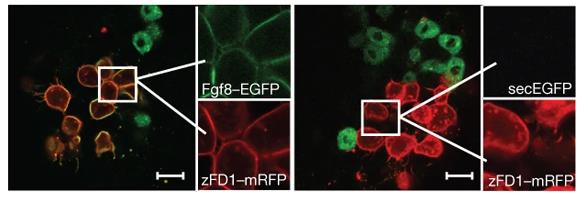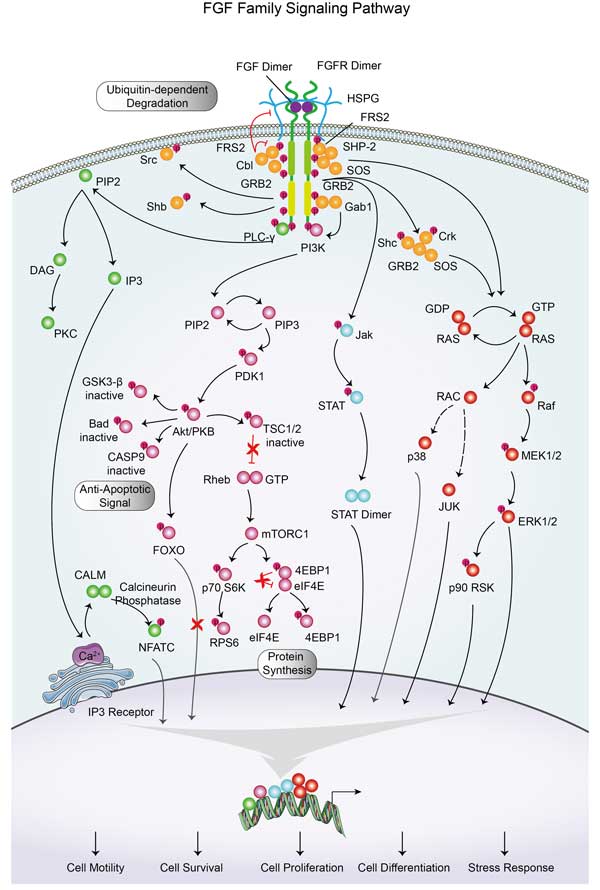FGF8
-
Official Full Name
fibroblast growth factor 8 (androgen-induced) -
Overview
The protein encoded by this gene is a member of the fibroblast growth factor (FGF) family. FGF family members possess broad mitogenic and cell survival activities, and are involved in a variety of biological processes, including embryonic development, cell growth, morphogenesis, tissue repair, tumor growth and invasion. This protein is known to be a factor that supports androgen and anchorage independent growth of mammary tumor cells. Overexpression of this gene has been shown to increase tumor growth and angiogensis. The adult expression of this gene is restricted to testes and ovaries. Temporal and spatial pattern of this gene expression suggests its function as an embryonic epithelial factor. Studies of the mouse and chick homologs revealed roles in midbrain and limb development, organogenesis, embryo gastrulation and left-right axis determination. The alternative splicing of this gene results in four transcript variants. -
Synonyms
FGF8;fibroblast growth factor 8 (androgen-induced);fibroblast growth factor 8;AIGF;androgen-induced growth factor;heparin-binding growth factor 8;KAL6;FGF-8;HBGF-8;MGC149376
Recombinant Proteins
- Human
- Chicken
- Mouse
- Horse
- Human/Mouse
- HEK293
- E.coli
- Mammalian Cell
- Human cells
- His
- Non
- Fc
- His&GST
- His&SUMO
Background
What is FGF8 Protein?
FGF8, or fibroblast growth factor 8, is quite a versatile player in the body. It belongs to the larger FGF family, known for encouraging cell growth, survival, and various biological roles. FGF8 is crucial during embryonic stages, helping set up and maintain the midbrain and hindbrain regions, which are essential for proper brain development. It's also important for limb formation, ensuring cells grow and survive to shape proper limbs. Challenges with FGF8 signaling can lead to issues like limb malformations. Besides its developmental roles, FGF8 is also associated with some cancers, contributing to tumor growth when misregulated. Overall, FGF8 serves key functions in development and has ties to certain cancer pathways, making it a significant focus for research.
What is the Function of FGF8 Protein?
FGF8, or fibroblast growth factor 8, is like a versatile multi-tool in the human body's development toolkit. It's part of a family known for getting cells to grow and survive, not just in very early embryonic stages but also when repairing tissues or when things are growing abnormally, like tumors. FGF8 is crucial for the normal development of the midbrain and hindbrain during embryogenesis. It sets up and maintains important borders in these brain regions, acts as an "organizer" for cell communication, and helps ensure that progenitor cells grow and differentiate correctly to form the brain's structure. It's also heavily involved in shaping our limbs and certain facial features by regulating the outgrowth of these structures and the differentiation of cells to make everything from bones to tendons. On top of that, FGF8 is related to certain reproductive and oral-maxillofacial issues, and its study is advancing potential therapies for diseases involving abnormal FGF8 activity.
FGF8 Related Signaling Pathway
FGF8, or Fibroblast Growth Factor 8, is a pretty essential player when it comes to signaling pathways in the body. This protein is part of the larger FGF family that's involved in a slew of cellular processes. FGF8 is crucial for embryonic development, especially in setting up important brain regions and ensuring limbs form properly. It sends signals that influence cell growth and differentiation, which basically means it helps decide what certain cells will become and how they'll grow. This is particularly vital for forming the midbrain and hindbrain boundary during development. In addition to shaping parts of the brain, FGF8 is also a key signal in the mix that forms our limbs; it promotes the growth and maintenance of limb bud structures. Its signaling involves binding to fibroblast growth factor receptors (FGFRs), kicking off a cascade of actions inside cells that drive various developmental processes. So, it's fair to say that without FGF8, our bodies would struggle to develop correctly from an embryo into a fully formed human.
FGF8 Related Diseases
FGF8, or Fibroblast Growth Factor 8, is a protein playing a crucial role in various developmental processes in the body, a key team player in cell signaling pathways. It's deeply involved in the early stages of development, like shaping the midbrain and hindbrain areas. Beyond that, FGF8 helps in forming and patterning limbs, making sure everything's growing just right. When there's a hiccup with FGF8's function, it can lead to some developmental disorders. For instance, its abnormal expression might link to issues like limb malformations or craniofacial abnormalities. Researchers are also keen on its role in certain cancers, as FGF8 might help tumors grow and spread by ramping up blood vessel formation or cell division, making it a potential target for cancer treatments. So, it's pretty central to how our bodies form and grow, as well as how various diseases might develop.

Fig1. Role of FGF-8 in osteoarthritis cartilage. (Haoran Chen, 2022)
Bioapplications of FGF8
Recombinant FGF8 protein is like a versatile tool in research and industry, used in various experimental setups to explore its role in developmental biology, disease modeling, and potential therapies. In the lab, scientists work with recombinant FGF8 to study how it influences cell growth, differentiation, and tissue development, especially when it comes to understanding limb and organ formation. It's also applied in experiments related to regenerative medicine, aiming to leverage its growth-promoting properties to repair or replace damaged tissues. In the industrial scene, FGF8 can be a component in developing treatments for conditions like cancer, as it plays a role in cell proliferation and tumor growth. Overall, recombinant FGF8 is a handy protein for diving into the intricacies of developmental processes and crafting innovative solutions in both health and disease contexts.
Case Study
Case Study 1: Shuizi Rachel Yu, 2009
We all know tissue differentiation and morphogenesis in multicellular organisms are steered by morphogens, which basically create concentration gradients. But figuring out how these gradients form is still a bit of a mystery. In our study, we found that Fgf8 morphogen gradients in live zebrafish embryos rely on two crucial things: the quick and free spread of single molecules through the space between cells, and the cells receiving them using a sink-like action controlled by endocytosis. We figured this out by directly observing single Fgf8 molecules inside living tissue using fluorescence correlation spectroscopy to accurately measure their movement and concentrations. By tweaking how much Fgf8 gets absorbed by its target cells, we managed to change the gradient's shape.

Fig1. Fgf8–EGFP accumulates on zFD1-overexpressing cells, whereas secEGFP does not.

Fig2. The Fgf8–EGFP concentration gradient becomes shallower in dnDYN-injected embryos and steeper in rab5c-cfp-injected embryos.
Case Study 2: Zulvikar Syambani Ulhaq, 2024
Nager syndrome, a rare condition linked to gene changes in SF3B4, often leads to facial and limb deformities. While SF3B4 has roles beyond its usual splicing duties, few studies have dug into how exactly it causes these defects. In our research with fish lacking sf3b4, we saw facial and body segment issues, alongside low fgf8 levels messing with FGF signaling and neural crest cell activity. We also noticed lots of cell death from oxidative stress, likely worsening bone issues. Interestingly, giving these fish extra FGF8 helped fix some problems, underscoring Fgf8's role in the syndrome. This work gives us a better grasp of the syndrome's molecular roots and hints at potential treatments to ease its symptoms and prevent major impacts.

Fig3. Phenotypes, alcian blue staining of sf3b4-MO co-injected with FGF8, and FGF8-injected larvae.

Fig4. Expression of fgf8a and acetylated tubulin in controls, sf3b4-MO injected embryos.
Quality Guarantee
High Purity
.jpg)
Fig1. SDS-PAGE (FGF8-01H)
.
.jpg)
Fig2. SDS-PAGE (FGF8-1500H)
Involved Pathway
FGF8 involved in several pathways and played different roles in them. We selected most pathways FGF8 participated on our site, such as MAPK signaling pathway,Ras signaling pathway,Rap signaling pathway, which may be useful for your reference. Also, other proteins which involved in the same pathway with FGF8 were listed below. Creative BioMart supplied nearly all the proteins listed, you can search them on our site.
| Pathway Name | Pathway Related Protein |
|---|---|
| Pathways in cancer | Fasl,PIK3R1,PPARD,RB1,ITGA2B,FGF10,PIK3CB,FOS,RALGDS,DAPK3 |
| PIK-Akt signaling pathway | PIK3R2,FASLG,LPAR2,INS,PPP2R5D,TRP53,IL7R,LAMA1,EPO,THBS4 |
| MAPK signaling pathway | PRKACBB,FGFR1A,TAB2,MAP3K4,NFKB1,MAP2K4,FGF20,CD14,MAPK14A,CACNA2D2 |
| Melanoma | FGF16,PIK3R3,FGF14,PTEN,HGF,FGF11,PIK3CB,FGF12,PDGFD,IGF1 |
| Regulation of Actin Cytoskeleton | VAV2,MYLPF,ITGA1,MYL5,ITGA5,FGF12A,ACTG1,WASLA,FGF20,LIMK1A |
| Rap signaling pathway | PGF,FGFR4,FGF17,RAPGEF1,IGF1,PARD6B,CALML5,ANGPT1,TLN1,ITGA2B |
| Ras signaling pathway | GNG11,FOXO4,GAB1,SHC2,RASAL3,FGF20,PLD2,PLA2G2D,AKT1,KSR1 |
Protein Function
FGF8 has several biochemical functions, for example, chemoattractant activity,fibroblast growth factor receptor binding,growth factor activity. Some of the functions are cooperated with other proteins, some of the functions could acted by FGF8 itself. We selected most functions FGF8 had, and list some proteins which have the same functions with FGF8. You can find most of the proteins on our site.
| Function | Related Protein |
|---|---|
| type 1 fibroblast growth factor receptor binding | FGF18,FGF17,NPTN |
| chemoattractant activity | HMGB2,LGALS3,VEGFA,FGF7,CCL3,SAA3,SCG2,HMGB1,SAA2,VEGFB |
| type 2 fibroblast growth factor receptor binding | FGF10,FGF17,FGF18,FGF7 |
| growth factor activity | GPI1,NRTN,FGF5,FGF13B,TGFA,FIGF,GDF10B,HBEGF,FGF10A,TFF1 |
| fibroblast growth factor receptor binding | FGF10B,Fgf15,FGF4,FGF5,KLB,FGF6B,FGF22,FGF3,FGF2,FGF16 |
Interacting Protein
FGF8 has direct interactions with proteins and molecules. Those interactions were detected by several methods such as yeast two hybrid, co-IP, pull-down and so on. We selected proteins and molecules interacted with FGF8 here. Most of them are supplied by our site. Hope this information will be useful for your research of FGF8.
FGFR1;FGFR2
FGF8 Related Signal Pathway
Resources
Related Services
Related Products
References
- Sautter, NB; Delaney, KL; et al. Tissue remodeling gene expression in a murine model of chronic rhinosinusitis. LARYNGOSCOPE 122:711-717(2012).
- Sato, A; Scholl, AM; et al. FGF8 signaling is chemotactic for cardiac neural crest cells. DEVELOPMENTAL BIOLOGY 354:18-30(2011).



